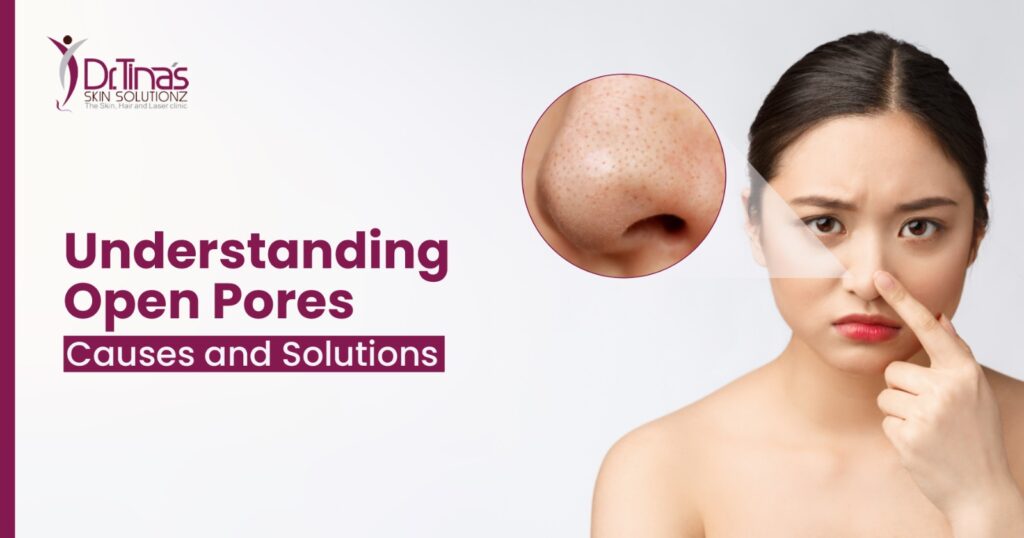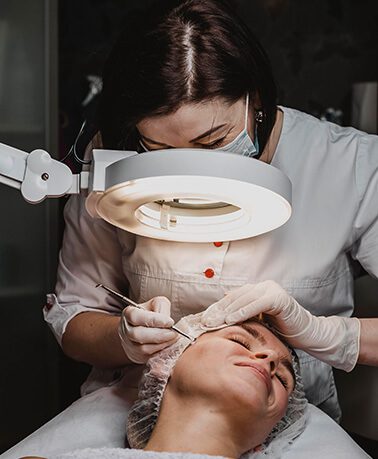Understanding Open Pores: Causes and Solutions

Open pores can be a common skin concern that many individuals, particularly those with oily or combination skin, struggle with.
These enlarged pores can impact the skin’s appearance, creating an uneven texture and causing the skin to look less smooth.
While open pores are not harmful, their presence can lead to concerns about acne, clogged pores, and the overall health of the skin.
Understanding the causes of open pores and addressing them with proper skincare can make a significant difference.
In this blog, we’ll explore what open pores are, why they occur, and how you can minimize their appearance with the best treatment for open pores.
What Are Open Pores?
Open pores are tiny openings in the skin’s surface that allow the skin to release sweat and sebum (natural oils). These pores are essential for regulating the skin’s temperature and maintaining hydration.
However, when pores become enlarged, they can become more visible, especially on the face.
Pores are most noticeable on the forehead, nose, chin, and cheeks, often referred to as the T-zone. They can appear larger due to excess oil production, clogged pores, or skin aging.
Open pores on the face are more prominent in areas where sebaceous (oil) glands are more active, contributing to the formation of blackheads or acne when the pores are clogged.
Common Causes of Open Pores
1: Excess Oil Production
Oily skin is one of the primary causes of open pores. Sebum is a natural oil produced by the sebaceous glands to keep the skin moisturized.
However, when these glands produce excess oil, it can build up in the pores, leading to their enlargement. As the pores stretch to accommodate the excess oil, they become more noticeable.
Excess oil can also attract dirt, bacteria, and dead skin cells, which can further clog the pores, making them appear larger. Managing oil production through the right skincare routine is crucial for minimizing open pores.
2: Genetics
Genetics also play a significant role in determining the size of your pores. Some people are simply predisposed to larger pores due to their genetic makeup. If your parents had larger pores, there’s a higher chance you will too. Although you cannot change your genetics, there are still ways to minimize the appearance of open pores through proper skincare and treatment.
3: Aging and Collagen Loss
As we age, our skin loses elasticity due to a decline in collagen production. Collagen is a protein that helps the skin maintain its firmness and smooth texture. When collagen breaks down, the skin becomes looser and saggy, which can cause pores to appear larger. Aging also slows down the skin’s natural ability to regenerate, exacerbating the appearance of open pores.
4: Sun Damage
Prolonged exposure to the sun’s UV rays can damage the skin’s collagen and elastin fibers, leading to a decrease in skin elasticity.
Sun damage causes the skin to lose its firm texture, which results in the enlargement of pores. Additionally, UV rays can cause the skin to produce more sebum, leading to further pore clogging. Therefore, protecting the skin from sun exposure is key to preventing the enlargement of pores.
5: Improper Skin Care Habits
Using harsh products or over-exfoliating can also cause open pores. Harsh products strip the skin of its natural oils, leading to dryness and irritation. In response, the skin may produce more oil, which can accumulate in the pores and cause them to enlarge.
Additionally, over-exfoliating can damage the skin’s barrier, making the pores more noticeable.
It’s essential to use products that are suitable for your skin type and not to overdo it with exfoliation.
6: Hormonal Changes
Hormonal imbalances, especially during puberty, menstruation, pregnancy, or menopause, can trigger increased sebum production, leading to enlarged pores. Hormonal fluctuations are a common cause of open pores, particularly in people with oily or combination skin.
How Open Pores Affect Your Skin
Open pores can lead to a variety of skin issues. When pores become clogged with oil, dirt, and dead skin cells, they can develop into blackheads or acne. This is particularly common in the T-zone area, where pores tend to be more prominent.
Psychologically, open pores can affect self-esteem, as people often feel self-conscious about their appearance. It’s important to address the issue to not only improve skin texture but also boost confidence.
Solutions to Minimize Open Pores
1: Consistent Cleansing Routine
A consistent cleansing routine is crucial in preventing clogged pores. Regular cleansing helps remove excess oil, dirt, and impurities that can enlarge pores. Use a gentle cleanser suited for your skin type to avoid stripping the skin of essential oils. Toners can also be helpful in reducing the appearance of pores by balancing the skin’s pH and removing excess oil.
2: Exfoliation
Exfoliating the skin gently helps to remove dead skin cells and prevent clogged pores. Use exfoliating agents such as AHA (Alpha Hydroxy Acid) or BHA (Beta Hydroxy Acid), which are known to improve skin texture and minimize pores. Exfoliate 2–3 times a week to avoid irritating the skin.
3: Using Pore-Minimizing Products
There are several products designed to help minimize the appearance of open pores.
Look for pore-minimizing serums, masks, and primers containing ingredients such as niacinamide, which helps tighten skin and reduce pore size.
Retinol, another potent ingredient, can also promote skin regeneration and reduce pore size over time.
4: Hydration
It’s important to keep the skin hydrated, as dry skin often leads to an overproduction of sebum. Use a lightweight moisturizer that suits your skin type to maintain a healthy moisture balance.
Hydrated skin is less likely to produce excess oil, which can contribute to enlarged pores.
5: Sun Protection
Sunscreen is essential in preventing sun damage, which accelerates the breakdown of collagen and elastin, leading to enlarged pores. A broad-spectrum sunscreen with an SPF of at least 30 should be applied daily to protect your skin from harmful UV rays.
6: Dermatological Treatments
For more stubborn cases of open pores, dermatological treatments such as chemical peels, microneedling, or fractional CO2 laser therapy can be effective.
These treatments promote skin regeneration and reduce the appearance of pores. Consult a dermatologist to determine the best treatment plan for your skin.
Lifestyle Tips to Prevent Open Pores
In addition to skincare, lifestyle habits also play a role in maintaining healthy skin. Eating a balanced diet rich in antioxidants, staying hydrated, and avoiding smoking can help improve skin health. Reducing stress and getting enough sleep also contribute to the overall well-being of your skin.
Conclusion
Open pores are a common concern that can affect the skin’s appearance and lead to further issues such as acne and blackheads. Understanding the causes of open pores and incorporating the right treatments into your skincare routine can help minimize their appearance. Consistency is key, and with the right care, you can achieve smoother, healthier skin.
If you’re struggling with open pores, take action now by adopting a consistent skincare routine and trying the best open pores treatments. Consider exploring Dr. Tina’s Skin Solutionz for tailored solutions that can help you achieve clear, smooth skin. Share your experiences or ask questions in the comments below—we’d love to hear from you!
Get to know these facts about open pores

Dr.Tina Ramachander is one of the best dermatologist in Bangalore and Medical Director at Dr.Tina’s Skin Solutionz, a skin care clinic in Bangalore. She completed her master’s in dermatology from the well acclaimed JJM Medical college in Karnataka and is now a practicising dermatosurgeon and Medical Cosmetologist in Bangalore.

